Modelling and simulating crack propagation in 3D-printed structures
Analyse comparative des modèles champs de phase pour la simulation de la propagation de fissure en milieux anisotropes
MEALOR Days
IMSIA, ENSTA Paris, CNRS, EDF, Institut Polytechnique de Paris 91120 Palaiseau, France
November 7, 2024
Fracture in 3D-printed structures
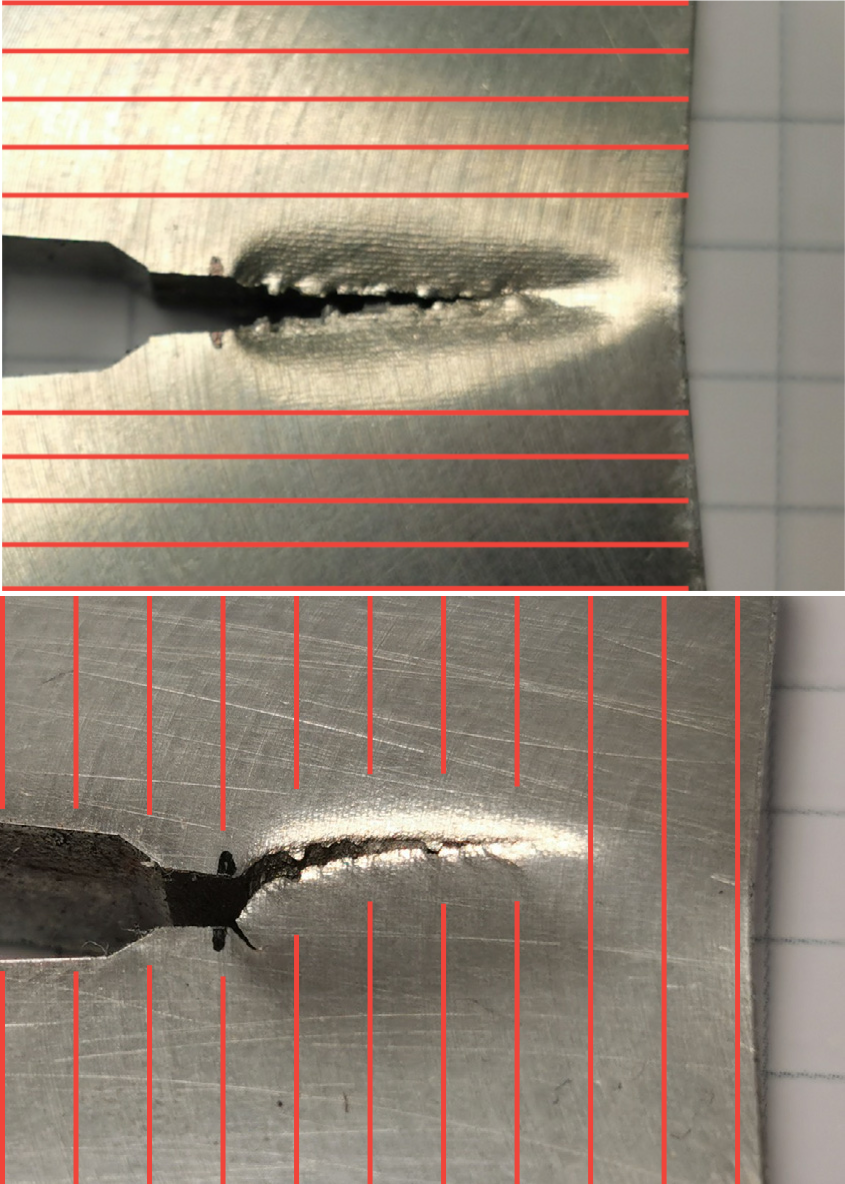
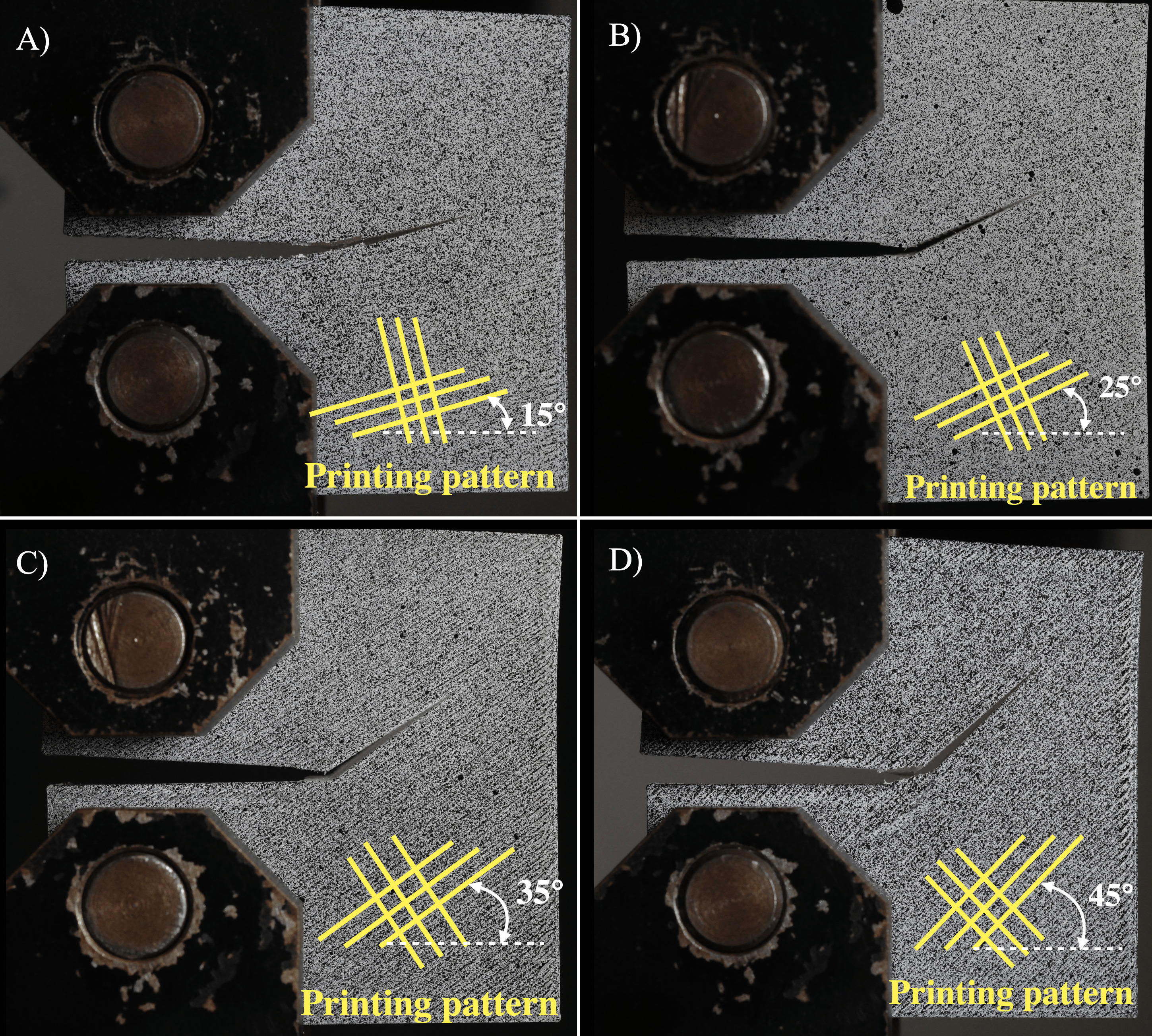
Global objective
Fracture mechanics problem
We consider
- a domain \(\Omega\) with a pre-crack \(\Gamma_0\),
- an elastic material (\(E\), \(\nu\)),
- a force or displacement load,
and we want to determine
- the crack-path,
- the force-displacement curve,
- the evolution of the displacement field.
To solve this problem, we want to employ numerical methods.
Accounting for fracture anisotropy
Generalization of the Maximum Energy Release Rate (GMERR)
The crack propagates when:
\[ G^*(\varphi) = G_c(\varphi) \implies \lambda = \sqrt{\frac{G_c(\varphi)}{G^*(\varphi)}}\]
in the direction that minimizes the load amplitude \(\lambda\)
\[ \varphi = \arg\min_{\varphi' \in [0, 2\pi]} \sqrt{\frac{G_c(\varphi')}{G^*(\varphi')}} \]
where \(G^*\) is obtained from Amestoy & Leblond (1992).
Strong vs Weak anisotropy : \(G_c^{-1} (\varphi)\)
Weak anisotropy
Strong anisotropy
How to parameterize \(G_c(\theta)\) ?
A general parameterization of \(G_c\) can be obtained using Fourier series1. \[ G_c(\varphi) = G_0 \left[ 1 + A_2 \cos(2 (\varphi - \theta_{2})) + ... + A_{2P} \cos(2P (\varphi - \theta_{2P})) \right]. \]
Plots of different \(G_c^{-1}(\phi)\)
\(A_2 = 0.5\)
\(\theta_2 = \pi/4\)
\(A_4 = 0.2\)
\(\theta_4 = 0\)
\(A_4 = 0.8\)
\(\theta_4 = \pi/6\)
Structural tensor: 2D Harmonic decomposition
Blinowski et al. (1996), Desmorat & Desmorat (2015)
The 2P-order model \[ G_c(\varphi) = G_0 \left[ 1 + A_2 \cos(2 (\varphi - \theta_{2})) + ... + A_{2P} \cos(2P (\varphi - \theta_{2P})) \right] \] can be written \[ G_c(\varphi) = G_0 \mathbf{A}_{2P} \bigotimes_{i=1}^{2P} \boldsymbol{n} , \quad \mathbf{A}_{2P} = \mathbf{I}_4 + \mathbf{1}^{\odot 2P-2} \odot \boldsymbol{H}_{2} + ... + \mathbf{1} \odot \boldsymbol{H}_{2P-2} + \mathbf{H}_{2P} \] where
- \(\mathbf{H}_{n}\) are totally symmetric and traceless
- \(H_{...00}^{n} = A_{n} \cos(n \theta_{n})\) and \(H_{...01}^{n} = A_{n} \sin(n \theta_{n})\) with \(n=2p\)
- \(\odot\) is the (totally) symmetrized tensorial product.
Regularization of the fracture problem
Francfort & Marigo (1998), Bourdin et al. (2000)
The state of a domain \(\Omega\) is described by:
- a displacement field \(\boldsymbol{u}(\boldsymbol{x})\),
- a crack phase field \(\alpha(\boldsymbol{x})\).
The state fields are governed by an energy minimization problem, \[ (\boldsymbol{u}, \alpha) = \arg\min_{\substack{\boldsymbol{u}' \in \mathcal{U} \\ \alpha' \in \mathcal{A}}} \ \underset{\text{elastic}}{\mathcal{E} (\boldsymbol{u}', \alpha')} + \underset{\text{dissipation}}{\mathcal{D} (\alpha')} - \underset{\text{external work}}{\mathcal{W}_{\mathrm{ext}} (\boldsymbol{u}')} \]
Different strongly anisotropic models
Isotropic fracture model
\[ \mathcal{D}(\alpha) = \frac{G_0}{c_w} \int_\Omega \frac{w(\alpha)}{\ell} + \ell \nabla \alpha \cdot \nabla \alpha \,\mathrm{d}x \]
Strongly anisotropic fracture models
Li & Maurini (2019), Gerasimov & De Lorenzis (2022), Rezaei et al. (2021) (in order)
\[ \begin{split} \mathcal{D}(\alpha) &= \frac{G_0}{c_w} \int_\Omega \frac{w(\alpha)}{\ell} + \ell^3 \nabla^2 \alpha : \mathbf{A} : \nabla^2 \alpha \,\mathrm{d}x \\ \mathcal{D}(\alpha) &= \frac{G_0}{c_w} \int_\Omega \frac{3}{b_w} \frac{w(\alpha)}{\ell} + \ell^3 \nabla \alpha \otimes \nabla \alpha : \mathbf{A} : \nabla \alpha \otimes \nabla \alpha \,\mathrm{d}x \\ \mathcal{D}(\alpha) &= \frac{G_c(\theta)}{c_w} \int_\Omega \frac{w(\alpha)}{\ell} + \ell \nabla \alpha \cdot \nabla \alpha \,\mathrm{d}x, \quad \theta = \arctan \left(- \frac{\nabla \alpha \cdot \boldsymbol{e}_2}{ \nabla \alpha \cdot \boldsymbol{e}_1} \right) - \frac{\pi}{2} \end{split} \]
Other anisotropic models: models with multiple order (Teichtmeister et al., 2017), multi-phase field models (Nguyen et al., 2017), etc.
In practice, it is not that simple …
Using the model of Gerasimov & De Lorenzis (2022) (Foc4)
We observe micro-zigzag on the crack path.
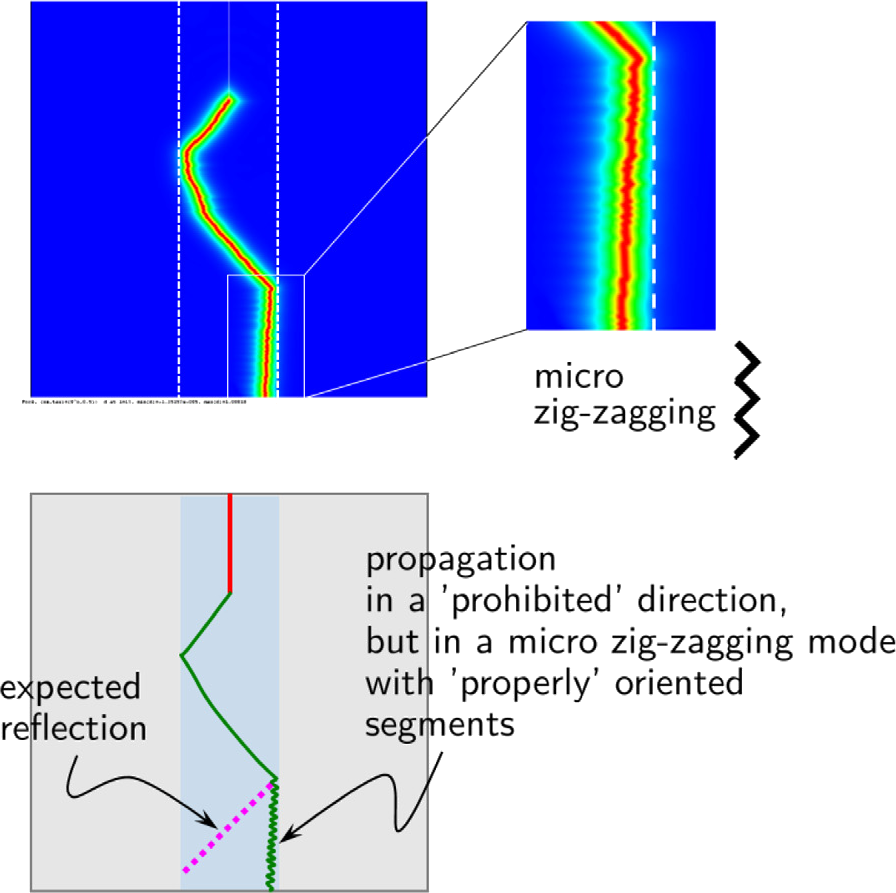 Fig. 15 of Gerasimov & De Lorenzis (2022)
Fig. 15 of Gerasimov & De Lorenzis (2022)
… and some more fundamental questions arises
Also discussed by Takei et al. (2013)
The crack propagates when
\[ G^*(\varphi) = G_c(\varphi) \implies \lambda = \sqrt{\frac{G_c(\varphi)}{G^*(\varphi)}}\]
in the direction that minimizes the load amplitude \(\lambda\)
\[ \varphi = \arg\min_{\varphi' \in [0, 2\pi]} \sqrt{\frac{G_c(\varphi')}{G^*(\varphi')}}. \]
Should this minimization be local or global ?
Global vs local minima in the GMERR
Global minimizer
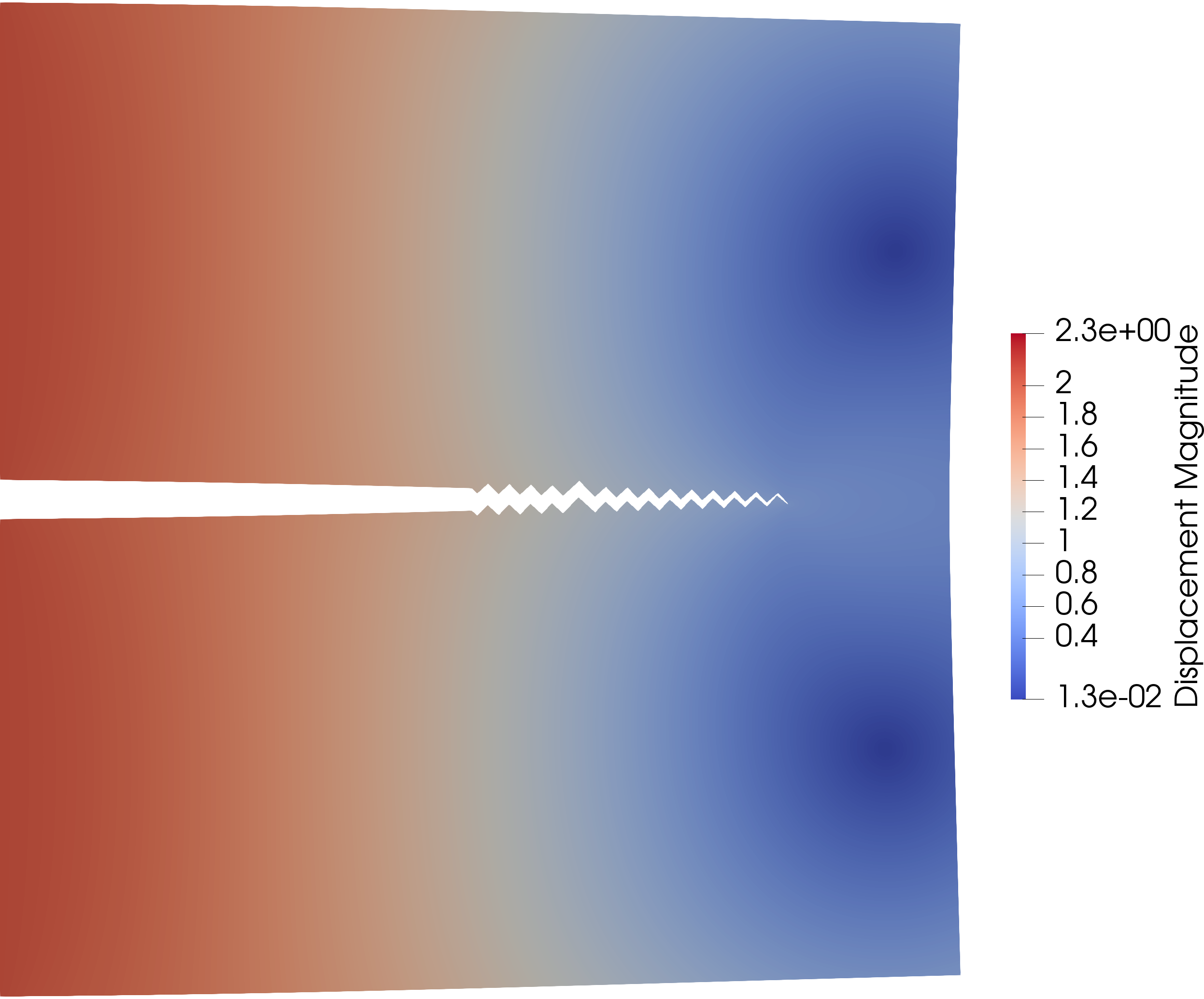
Note: The zig-zag amplitude reduces with crack increment size.
Local minimizer
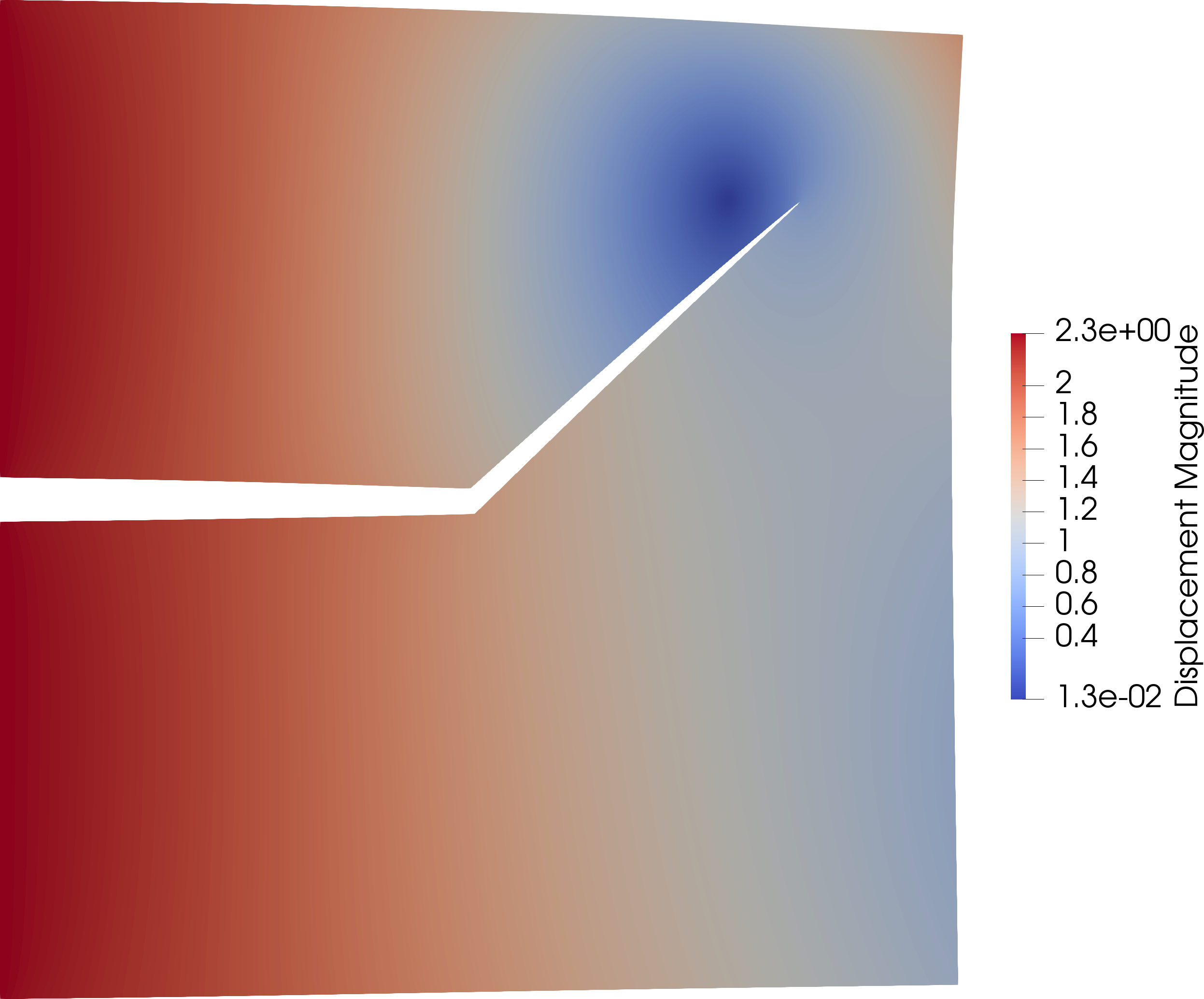
Which solution is correct?
Experiments on strongly anisotropic specimen
PhD thesis of Zhai (2023)
Experiments
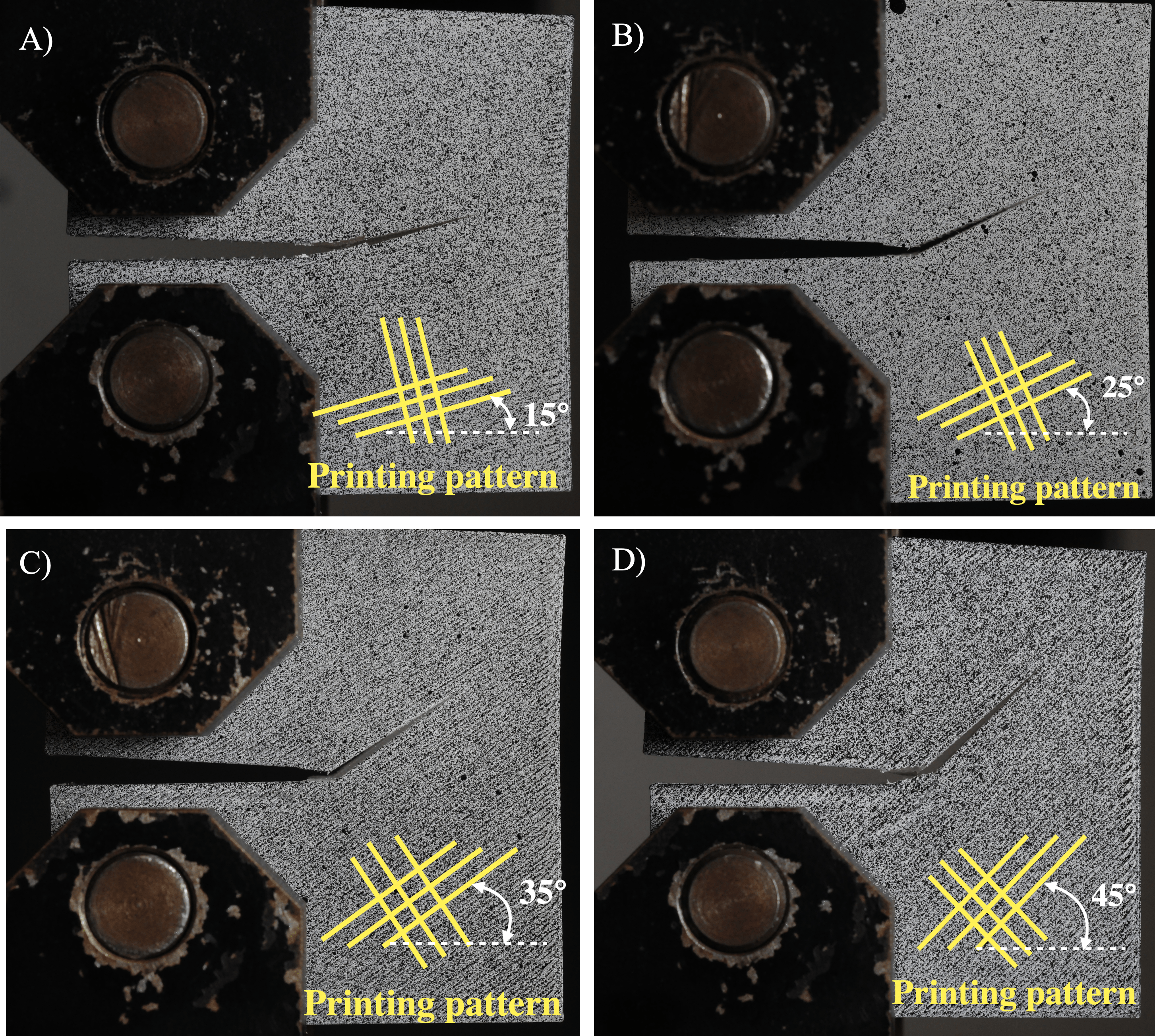
Local minimizer

According to those experiments, the local minimizer seems to be valid one.
What about anisotropic phase-field fracture ?
Current partial conclusion
Suggestions
- Incremental solution of the phase-field problem
- Use a local minimizer for each load increment for the crack phase.
- Load step influence on the crack path
- Is there a CFL-like conditions ?
- Instable crack propagation
- Dynamics (physic solution)
- Indirect control1 (quasi-static solution)
Crack propagation in strongly anisotropic media
Using the model of Rezaei et al. (2021)
GMERR
Anisotropic phase-field fracture
Promising first (coarse) results !
Thank you for your attention !
F. Loiseau, V. Lazarus
flavien.loiseau@ensta-paris.fr
Next objective
More complex fracture case with anisotropic phase-field fracture